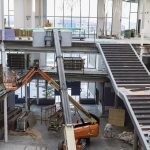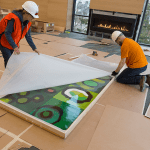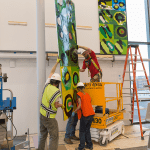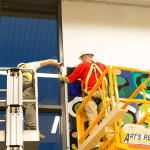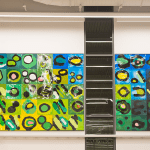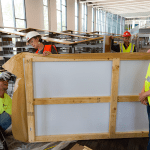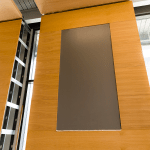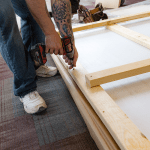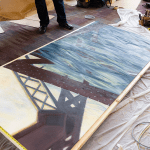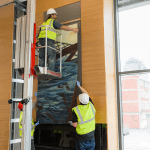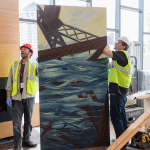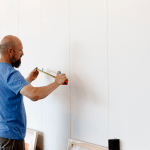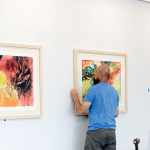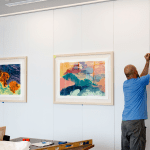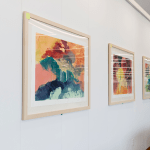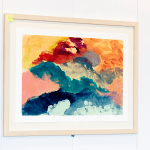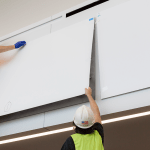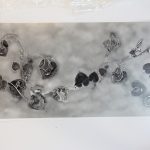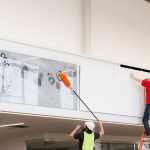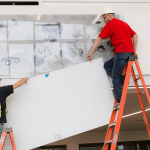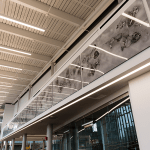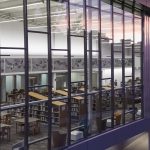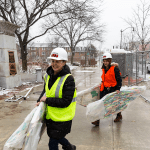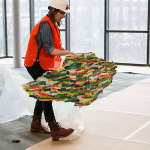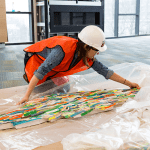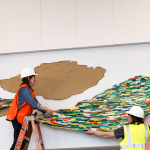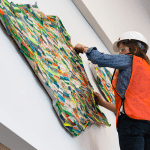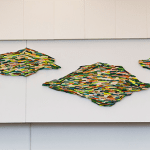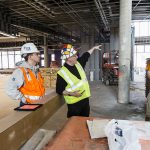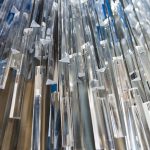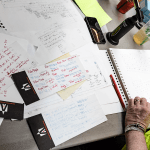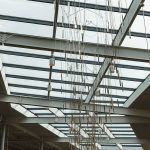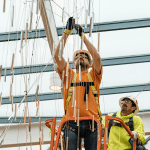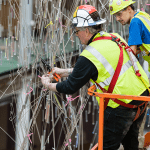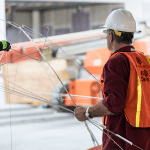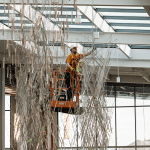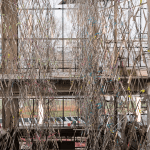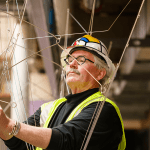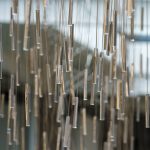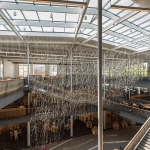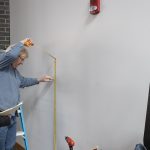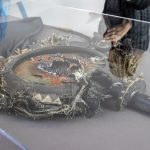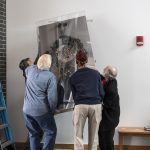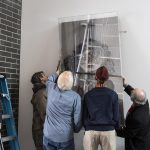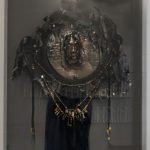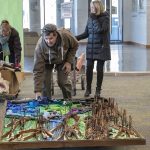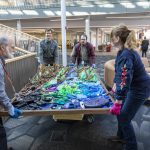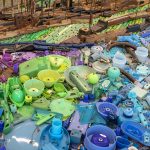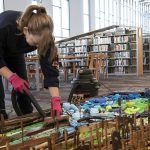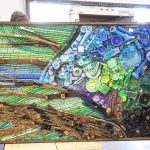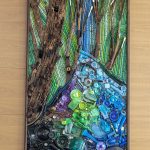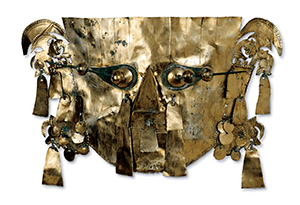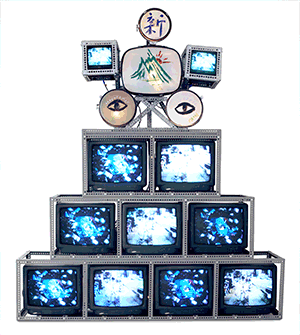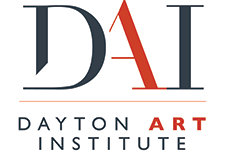Main Library
About the Main Art Installation and Artists
Susan Byrnes (b.1967) American, VISCOSITY GARDEN, 2015, cast rubber, Collection of the Dayton Metro Library, 2017.5
Works by Cincinnati artist Susan Byrnes encompass a variety of media. This large scale work of 90 individual tiles was formed by pouring pigmented liquid rubber into shallow molds at varying stages of curing. Byrnes’ early studies were in photography, film and video and her later studies were in traditional cast metal sculpture and audio production. Byrnes envisions this piece to be a broad abstract waterscape that provides a bold, playful and colorful respite for the eyes, to inspire the imagination of the library visitor.
About the Artist
SUSAN BYRNES is a visual artist whose work encompasses traditional and contemporary forms and practices, including sculpture, multimedia installation, radio broadcasts, writing and curatorial projects. Her art has been exhibited in galleries and museums throughout the United States. Byrnes serves as an artist in the Ohio Arts Council Arts Learning Artist in Residence Program. She is the recipient of a Cincinnati Art Ambassador Fellowship and a Montgomery County Arts and Culture District Individual Artist Grant. She earned an MFA from Eastern Michigan University and a BFA from Syracuse University. Byrnes resides in Cincinnati, Ohio. For more information, please visit: www.susanbstudio.com.
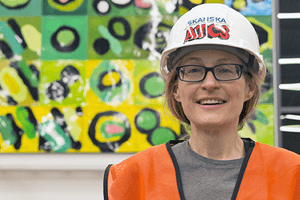
Gretchen Durst Jacobs (b. 1959) American, TRUSS AND RIVER, 2016, Oil on panel, Collection of the Dayton Metro Library, 2017.6
Dayton artist Gretchen Durst Jacobs deconstructs the oldest type of modern bridge truss. Jacobs ignites the feeling of tension, compression, structure, power and movement in the careful consideration of each strut’s placement. Jacobs values the balance and tension of these interactions as she explores the duality of the abstract and representational aspects of painting.
About the Artist
GRETCHEN DURST JACOBS received her BFA from Wright State University in 2000 and her MFA from The University of Cincinnati in 2007, with a concentration in painting. Her artistic vision stems from a deep reverence for the natural world. By working primarily en plein air, out-of-doors, she directly plugs into the source that inspires her work. Jacobs has shown in numerous group and solo exhibitions locally and nationally. For more information, please visit: www.gretchendurstjacobs.com.
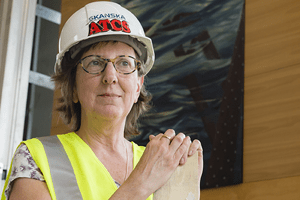
Katherine Kadish (b. 1939) American, RIVER 1-5, 2015, Monotype, Collection of the Dayton Metro Library, 2017.7-11
A Yellow Springs based artist, Katherine Kadish created these five monotypes in New York City in collaboration with master printer Lisa Mackie. In her signature abstract and expressive style, Kadish addresses themes of transformation, the transitory nature of material things and the value of each moment we fully experience. Color is the lifeblood of Kadish’s work, followed by light and shadow … all elements that are impermanent and subject to context, time, weather, and memory. In this series, the prints relate to each other but do not form a continuous image. Each print contains elements of water, sky, landscape and ultimately the river.
About the Artist
KATHERINE KADISH received her B.F.A. in painting and design from Carnegie Mellon University and her M.A. in art history from the University of Chicago. Known for her strong use of color, Kadish uses the visual world as a starting point and then simplifies the forms she sees sometimes leaving behind all reference to the known subject. Kadish has exhibited her work internationally in addition to having been awarded many prestigious fellowships and residencies. Kadish lives in Yellow Springs, Ohio, and maintains her studio in the nearby village of Clifton and works regularly in New York City. For more information, please visit: www.katherinekadish.com.
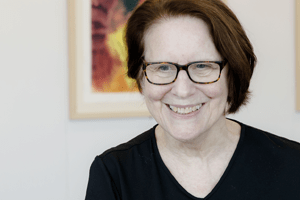
Paula Willmot Kraus (b.1957) American, MORNING GLORY, 2016, Inkjet Print, Collection of the Dayton Metro Library, 2017.12.1-12
Dayton artist Paula Willmot Kraus draws largely from her immediate surroundings, often using nature and natural forms to explore memory, emotions, and formal aesthetics. She began her career in photojournalism and moved into fine art photography to tell her own visual stories. Intrigued by Monet’s response to light, Kraus relates photography or “drawing with light” to a painter’s process of mixing paint to create the initial palette of raw material. For Kraus, light is her raw material.
About the Artist
PAULA KRAUS Dayton artist, Paula Kraus is currently an adjunct professor of photography at Wright State University and at Stivers School for the Arts. She holds an MA in Photography from Antioch University and a BS from Pennsylvania State University. Kraus’ photographs have been exhibited in galleries and museums nationally, including The Dayton Art Institute, Dayton Visual Arts Center, Fort Wayne Museum, Tiffin University, Riffe Gallery, and Eastern Washington University. She has been awarded two Montgomery County Individual Artist Fellowships and one Ohio Arts Council Individual Artist Grant. For more information, please visit: www.paulawillmotkraus.com.
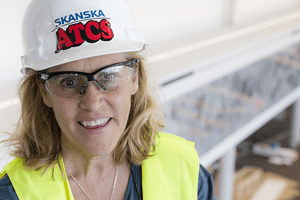
Andrea Myers (b. 1979) American, EN PLEIN AIR, 2016, machine sewn, fabric collages, Collection of the Dayton Metro Library, 2017.13.1-6
A Wooster, Ohio based artist Andrea Myers identifies herself as a painter who constructs painterly sculptures and installations. Myers explores the boundaries between two-and three-dimensions in her textile wall pieces. She sews together rectangular sections of fabric to create collages with a variety of textures that reference the gesture of painting
About the Artist
PAULA KRAUS, a Dayton artist, Paula Kraus is currently an adjunct professor of photography at Wright State University and at Stivers School for the Arts. She holds an MA in Photography from Antioch University and a BS from Pennsylvania State University. Kraus’ photographs have been exhibited in galleries and museums nationally, including The Dayton Art Institute, Dayton Visual Arts Center, Fort Wayne Museum, Tiffin University, Riffe Gallery, and Eastern Washington University. She has been awarded two Montgomery County Individual Artist Fellowships and one Ohio Arts Council Individual Artist Grant. For more information, please visit: www.paulawillmotkraus.com.
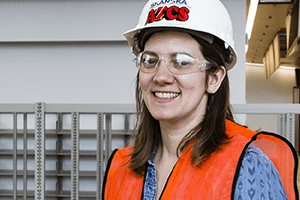
Terry Welker (b.1955) American, FRACTAL RAIN, 2015, stainless steel wire, Swarovski crystal beads and acrylic prisms, Collection of the Dayton Metro Library, 2017.14
This large-scale mobile by Dayton artist Terry Welker emulates the visual impression of rain. Welker works to extend the language of mobiles by animating form, space and surface with motion. Using the inherent challenge of gravity and the mystery of delicate balance he orchestrates movement that allows the observer to move from simple viewing to the enjoyable act of “watching”.
About the Artist
TERRY WELKER, is an architect/artist living in Kettering, Ohio. He began his formal education in fine art but later moved toward architecture, completing his graduate work at the University of Cincinnati in 1987. An award-winning architect, he opened his own office in 1994 and created the Archetype Gallery serving artists of the Miami Valley. Today, as a distinguished member of the American Institute of Architects, his teaching background, gallery experience, and architectural knowledge in design and structure all inform his work as a sculptor. Welker’s work is held in numerous public and private collections both nationally and internationally. For more information please visit: www.welkerstudio.com.
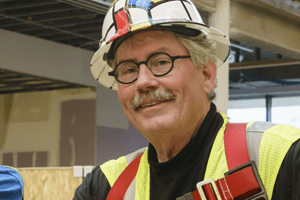
Willis “Bing” Davis (b.1937) African American, URBAN MASK #1: CULTURAL WARRIOR SERIES, 2019, Clay and found objects, Collection of the Dayton Metro Library, 2019.1
Dayton artist Willis “Bing” Davis understands the existence of masks as a unifying force that helps a community acknowledge and appreciate the commonality of our existence as one human family. Using found objects and other materials from the urban landscape – items and materials that have been thrown away as if devoid of any value or use – Davis continues the mask making tradition which has been a vital part of many aspects of arts, culture, community and existence. The influence of traditional cultures, especially African art and culture is a foundational aspect of Davis ’work.
About the Artist
Dayton artist Willis “Bing” Davis is a graduate of DePauw University. Davis is the founder of SHANGO Inc., a non-profit organization designed to provide a positive environment for Dayton's youth, where they can learn about art and culture through art expression. Davis taught art from 1960-1998 when he retired to open the Davis Art Studio and EbonNia Gallery in the Historical Wright-Dunbar Business District in West Dayton, Ohio.
He has exhibited his art professionally since 1960 throughout the U.S.A. and abroad including England, France, Germany, China, Senegal, Ghana, Gabon, Nigeria, and West Africa. He has been the recipient of State, National, and International awards as an artist and educator. Davis continues to produce art and conduct art workshops in and outside of his studio. For more information about this artist please visit: http://bingdavis.tripod.com
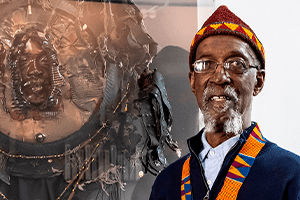
Michelle Stitzlein (b.1967) American, STREAM AT HUFFMAN PRAIRIE, 2019, Repurposed materials, Collection of the Dayton Metro Library, 2019.2
Baltimore, Ohio artist Michelle Stitzlein creates art using repurposed materials and found objects, to depict imagery inspired by the natural world. Only intent study reveals the individual identities of the hundreds of objects within each of her pieces. These objects, once assigned and confined to a certain function or task, find a new aesthetic incarnation within her work as color, texture, form and pattern. Through the process of cutting, dismantling and placement, she coaxes the multiple, disparate objects into unusual relationships to unite as a bold, visual whole
About the Artist
MICHELLE STITZLEIN is a Baltimore, Ohio based artist who works with repurposed objects to create large scale works. Stitzlein was born and raised in the small town of Coshocton, Ohio, and maintains a studio in a re-purposed, former grange hall in the rural community of Baltimore, Ohio. Informed by memories of a thrifty, fabric-scrap-reusing grandmother, Stitzlein creates sculpture with found items that resonate with fortune and abundance but that also address ideas of economic stress and natural depletion. Utilizing materials she scavenges and collects, her work is mindful of the resourcefulness and bootstrap mentality of farmers, homemakers and the depression era, as well as folk artists and craftsmen in developing countries. Her work and imagery venerates imperfections found in the handmade, the patched/mended and secondhand and pays deference to nature and habitat enduring continual loss and destruction due to the industrial pursuit of new and raw resources.
Stitzlein holds a BFA from the Columbus College of Art & Design, in Columbus, OH. Her work has been exhibited in numerous venues across the US. She has been a resident at the Millay Colony of Arts, NY, and was awarded Individual Excellence Grants from the Ohio Arts Council in 2008 and 2017. For more information about this artist please visit: http://www.artgrange.com
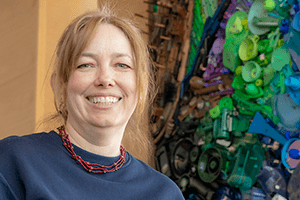
The Stories Behind the Main Library Art Inspiration
From the Collection of the Dayton Art Institute
CHIMÚ CULTURE, Peru, Mummy Mask, 1100-1400 CE, Hammered gold, copper, 10 ½ x 16 ½ inches, The Dayton Art Institute, Museum purchase with funds provided by Mr. and Mrs. Ralf Kircher and Mr. Louis Jacobs. 1967.46
This mask, made by the Sicán people of ancient Peru, is exceptionally complete, being comprised of 35 separate pieces. Fractional patterning highlights the way in which small parts make up a whole; this principle, evident in the composition of the mask, is a primary aesthetic value expressed in the new design of Main Library.
View this artwork and learn more by clicking here, opens a new window or visit The Dayton Art Institute.
CLAUDE MONET (1840-1926) French, Waterlilies, 1903, Oil on canvas, 32 x 40 inches, The Dayton Art Institute, Gift of Mr. Joseph Rubin, 1953.11
This depiction of water might seem tranquil, but the changes in culture and technology that led to its creation were radical. The advent of trains and portable paint tubes facilitated the artist’s ability to travel outside of the urban city center and paint directly from nature, or en plein air, as never before. Monet and other Impressionist painters, with their focus on spontaneity and capturing the changing quality of light, transformed the nature of painting forever.
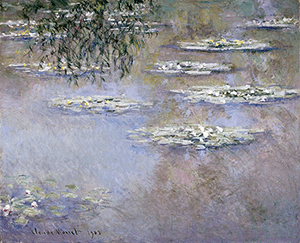
NAM JUNE PAIK (1932- 2006) American, South Korean, Four Decades, 1989, Mixed media, 96 x 80 x 23 ¼ inches, The Dayton Art Institute, Gift of Society Bank through exchange, 1999.123
Nam June Paik was among the first artists to utilize technology and video. He also embraced the unpredictable qualities of art. Paik disrupts expectations of the function of mass-produced objects and images by removing them from their accustomed setting, as exemplified in this sculpture composed of televisions whose pictures are random and have been manipulated by the artist.
View this artwork and learn more by clicking here, opens a new window or visit The Dayton Art Institute.
How did these pieces inspired our artists?
“Viscosity Garden is inspired by two pieces in the DAI collection: Waterlilies by Claude Monet, and Nam June Paik’s Four Decades. Monet’s lily pad forms and contrasting flatness and depth of visual space, along with Paik’s TV-based sculpture that incorporates hard edges of a grid format, bold color, movement and repetition, provided wonderful departure points for considering scale, color, and depth in the reimagining of a new landscape-based work.” Susan Byrnes, artist
“Truss and River received its inspiration from Monet’s response to the reflective and abstract quality of water in Waterlilies. Partnering this with Nam June Paik, Four Decades, which evokes ideas of new and old technology, Truss and River was created in the spirit of ‘bridging a gap from old to new.’ The Truss design of the Miami River Railroad Bridge is one of the ‘oldest types of modern bridges.’ Truss and River uses the geometry of the bridge to frame vignettes of the Miami River below.” Gretchen Durst Jacobs, artist
“Of all the painters I have admired over time, Monet is one of those who have had the most lasting influence on my work. He deals with all the elements in nature that fascinate me: light, shadow, nuances of color, as well as weather, season and time of day. His ability to combine sky, landscape, reflections, and water have inspired these River monotypes. I hope to evoke a feeling of Dayton’s beautiful Riverscape.” Katherine Kadish, artist
“My work has always been informed by nature and in this I share a sensibility with the impressionists. The contradiction of ideas surrounding artwork inspired by nature but created entirely with discarded materials left over from mass consumerism is intriguing to me. It’s something of a full circle story. Raw resources are extracted and harvested from the earth to manufacture solid goods and household wares and then those same items are disposed of by the community and scavenged by myself to create a vague essence of nature. I find the concept simultaneously disturbing and comforting. At once, an insult and a tribute to Mother Nature.” Michelle Stitzlein, artist
“Impressionist painter Claude Monet said, ‘One instant, one aspect of nature, contains it all.’ I believe the garden – with its rhythms, its seasons, its beauty, and its deaths – reflect that ‘all.’ I use tones, not color, in forming the image. The flow of flowers, leaves, and vines on water, in conjunction with the sky’s reflection, evokes Earth’s respirations. I replace brushstrokes with layers, building the canvas and recalling Monet’s layers of paint.” Paula Willmot Kraus, artist
“Monet utilized an ‘en plein air’ approach to his painting, being immersed in the environment and painting directly what he perceived. Following the rhythm and forms of the lily pads within his painting, my six textile pieces generate a similar visual movement spanning across the wall, unbound from the canvas, sparking life and physicality of the forms in the space.” Andrea Myers, artist
“Monet used a contemporary palette in Waterlilies to give an impression of refracted and reflected light. Fractal Rain relies on natural light to project a shared memory of rain with polished steel wires. The prisms are inspired by the Chimú Mummy Mask idea of fractals, the whole comprised of many parts. This work also responds to our infamous 1913 flood. Rain can evoke a positive emotional response while also reminding us that strong rains are a precursor to floods.” Terry Welker, sculptor and architect
“Using discarded materials from the urban landscape speaks to me - I feel the energy and potential use in these cast-off objects - they ignite my imagination and creativity. Urban Mask #1: Cultural Warrior reflects an aesthetic and historical link to the rich artistic heritage of African art and builds on the mask making tradition of the people of ancient Peru.” Willis “Bing” Davis, artist
Thank you to our partner,
the Dayton Art Institute, opens a new window.
Photos of ReImagining Works pieces taken by Andy Snow.

